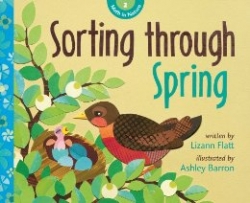Search for Resources
Description
"Sorting through Spring" is the second book of the "Math in Nature" series and contains the same engaging illustrations and lively prose that were used in the first book "Counting on Fall". In this story children are encouraged to look for patterns in nature and apply these patterns through activities like graphing and determining probability. The book is designed to be interactive as students do activities such as mimicking the prairie chicken dance! The story also asks students thought provoking questions such as "would rain fall in a rhythm?" that are intended to foster an appreciation for the natural world.
An accompanying teacher's guide with notes and activities can be downloaded here for free.
General Assessment
Recommendation of how and where to use it
This book has an accompanying teacher's guide available for free download. The excellent guide provides activities that support math, science, language arts and visual arts outcomes. An example activity is "Equal Eggs" where students explore simple equations using <, = and >.
Just as the first book could be used as a precursor to a series of math lessons, so can "Sorting through Spring" be used as an introduction to a numeracy unit on patterns and relationships. The story would be especially valuable in introducing and extending the topic of patterns with students. The book could be read by the teacher with the students copying the patterns described. Students could then be challenged to create their own pattern, and finally the class could go outside to discover patterns in nature.
One section of the book asks students to look at a graph and identify where the mosquitoes should lay their eggs. This would make an interesting cross-curricular math and science project for the spring months. A teacher could set up sites on the school grounds with varying amounts of standing water. Students could examine the sites for mosquito larvae and then graph their results. Another math/science lesson could be based on the section of the book that looks at morning, noon and night. Students could examine factors such as temperature, shadow length and height of the sun to help them compare between the three time periods.
Relevant Curriculum Units
The following tool will allow you to explore the relevant curriculum matches for this resource. To start, select a province listed below.
- Step 1Select a province
- Alberta
- Step 2Select a grade level
- Kindergarten
- Step 3Select a subject
- Math
- Step 4Relevant matches
- Number: Quantity is measured with numbers that enable counting, labelling, comparing, and operating
- Patterns: Awareness of patterns supports problem solving in various situations.
- Grade 1
- Step 3Select a subject
- Math
- Step 4Relevant matches
- Number: Quantity is measured with numbers that enable counting, labelling, comparing, and operatin
- Patterns: Awareness of patterns supports problem solving in various situations
- Grade 2
- Step 3Select a subject
- Math
- Step 4Relevant matches
- Number: Quantity is measured with numbers that enable counting, labelling, comparing, and operating.
- Patterns: Awareness of patterns supports problem solving in various situation
- British Columbia
- Step 2Select a grade level
- Kindergarten
- Step 3Select a subject
- Math
- Step 4Relevant matches
- Numbers represent quantities that can be decomposed into smaller parts.
- Repeating elements in patterns can be identified
- Grade 1
- Step 3Select a subject
- Math
- Step 4Relevant matches
- Numbers to 20 represent quantities that can be decomposed into 10s and 1s.
- Repeating elements in patterns can be identified
- Grade 2
- Step 3Select a subject
- Math
- Step 4Relevant matches
- Numbers to 100 represent quantities that can be decomposed into 10s and 1s
- Manitoba
- New Brunswick
- Newfoundland & Labrador
- Northwest Territories
- Nova Scotia
- Step 2Select a grade level
- Kindergarten
- Step 3Select a subject
- Math
- Step 4Relevant matches
- Number
- Patterns and Relations
- Grade 1
- Step 3Select a subject
- Math
- Step 4Relevant matches
- Number
- Patterns & Relations
- Grade 2
- Step 3Select a subject
- Math
- Step 4Relevant matches
- Mathematics 2: Number
- Mathematics 2: Patterns & Relations
- Nunavut
- Ontario
- Prince Edward Island
- Quebec
- Saskatchewan
- Yukon Territory
- Step 2Select a grade level
- Kindergarten
- Step 3Select a subject
- Math
- Step 4Relevant matches
- Numbers represent quantities that can be decomposed into smaller parts.
- Repeating elements in patterns can be identified
- Grade 1
- Step 3Select a subject
- Math
- Step 4Relevant matches
- Numbers to 20 represent quantities that can be decomposed into 10s and 1s.
- Repeating elements in patterns can be identified
- Grade 2
- Step 3Select a subject
- Math
- Step 4Relevant matches
- Numbers to 100 represent quantities that can be decomposed into 10s and 1s
- The regular change in increasing patterns can be identified and used to make generalizations
Themes Addressed
Ecosystems (1)
- Appreciating the Natural World

